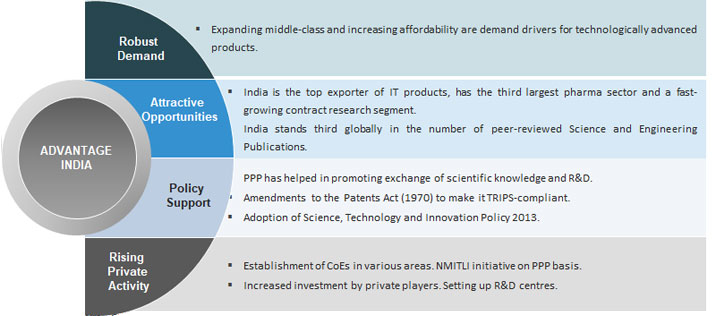Indian Economy
India: The Tech Garage of The World
- 09 Sep 2020
- 8 min read
This editorial analysis is based on the article India can soon be the tech garage of the world which was published in Live Mint on 9th of September 2020. It analyses the opportunities before India to become a technological superpower of the world.
The strong and sustained growth and innovation in the technology space presents a unique opportunity for India to position itself as the ‘Tech Garage of the World’ i.e, a technological powerhouse. Through the development of innovative digital and technology solutions, India can successfully find solutions to the massive and intractable challenges across several sectors.
Opportunities
Unaffected By Covid-19 Pandemic
- Even as the world continues to grapple with the Covid-19 pandemic, the remarkable resilience of India’s tech industry has been on display, with investments soaring to a mammoth $38 billion.
- A significant portion of these investments went to software based companies, which witnessed a major growth brought about by an increasing demand for digital tools and automation amid the current crisis.
Growing Market
- Eight of the world’s 10 richest companies that grew and expanded lately were technology companies.
- The fastest growing jobs on LinkedIn’s list of emerging jobs globally are artificial intelligence specialist and data scientist.
- During the covid period itself, Apple, Microsoft, Amazon, Facebook and Google enhanced their market capitalization by over $1 trillion.
Vibrant Ecosystem
- India is the youngest country in the world with demographic dividend and a vibrant startup ecosystem.
- In 2019 alone, over 1,300 startups were added, thereby solidifying India’s position as the third largest startup ecosystem in the world.
- Private equity investments hit a 10-year-high in 2019, attracting $17.3 billion and registering a yearly growth of 60.5%
Initiatives In This Regard
- The Prime Minister recently entrusted NITI Aayog with the task of developing technological products in partnership with the private sector, which would enable India to leapfrog in the post-covid era which are currently in different stages of evolution.
- The products and solutions showcased by NITI Aayog include:
- Unnati: A technology platform upskilling blue and grey collar workers.
- KrishiNeev: Agriculture platform for price forecasting, productivity, quality certification and traceability. The platform claims to use blockchain technology as well as artificial intelligence and machine learning to arrive at outcomes
- Unified Logistics Interface Platform (ULIP): An integrated multi-modal platform for digitising supply chain issues to address the logistics sector.
- SamShiksha: The platform has been conceptualised as an online university of the future and one-stop platform for higher education.
- KYC Setu: An integrated platform for digitally sharing KYC-data by individuals with new service providers.
- Kashi: The cash over internet service will provide low cost digital lending solutions to farmers and labourers on their direct benefit transfer (DBT) accounts.
- Swasth: A telemedicine app with over 5000 registered doctors will focus on integrated services for health issues, including mental health and integration of hospitals and doctors.
- The Prime Minister also launched the Atma Nirbhar Bharat App Innovation Challenge to encourage the creation of world-class made in India Apps and the response was overwhelming.
- The Atal Innovation Mission (AIM) is driving Atal Tinkering Labs with Artificial Intelligence, and robotics and 3D printing are being taught from class VI onwards.
- AIM also supports incubators and has catalysed a creative and innovative culture.
- National Health Stack and Aarogya Setu were developed envisioning a cohesive future for a healthtech ecosystem in India with public and private participation.
- One of the most powerful examples of the potential that India has is the success of the UPI platform in the digital financial inclusion space.
- UPI, is just 4 years old but reports 10 times the number of transactions as compared to the other transactions e.g. that of through Decade-old American Express.
Challenges
- The development of these world-class products requires skilful application of artificial intelligence.
- This necessitates critical inputs like flow of data-hungry young entrepreneurs, AI algorithm engineers, computing powers, and AI-enabling policy environment.
- While India has humongous data, thanks to mobiles and low data costs and top-class start-up entrepreneurs, it lacks in product managers, AI scientists, product designers and software engineers.
- Another challenge would be to make it inclusive so that it reaches most people and must also be safe so that any issue of privacy and data theft don’t arise.
Way Forward
- Our Engineering colleges must be reoriented to produce AI engineers who can partner tech entrepreneurs to launch cutting-edge global tech companies.
- The government has a crucial role to play in positioning India as the Tech Garage of the World. It should act as a catalyst, and bring together the synergies of the private sector with the aim of innovating for India and the world.
- It has the potential to provide an enabling environment and a favourable regulatory ecosystem for the development of technology products and provide the size and scale necessary for their rollout.
- The product development should ideally be undertaken through private entrepreneurship, with the government acting as a facilitator.
- The key principles of product design should incorporate transparency, security and ease of access.
- The products must have open architecture, should be portable to any hosting environment and should be available in official and regional languages.
|
Drishti Mains Question India is in a bright spot to harness the power of technology and become a technological powerhouse of the world. Discuss. |
This editorial is based on “Grim Sovereign Tangle: On GST compensation standoff” which was published in The Hindu on September 3rd 2020. Now watch this on our Youtube channel.







